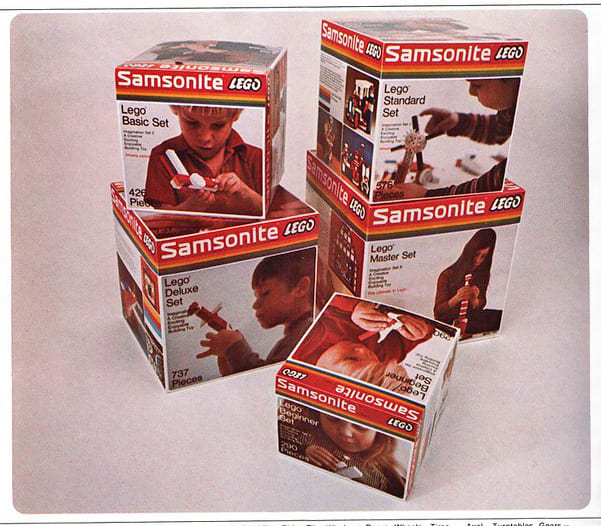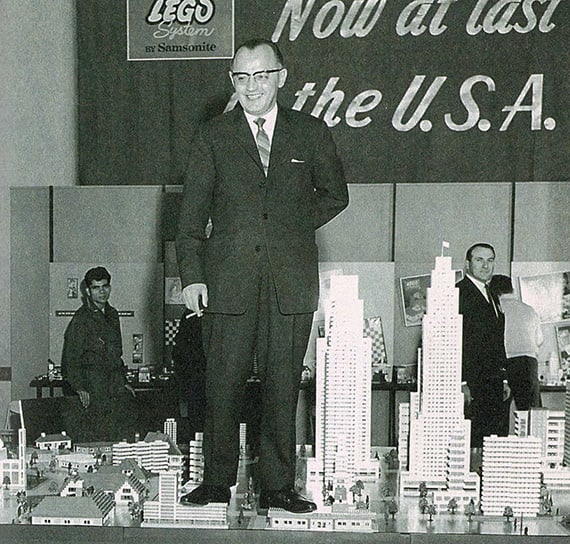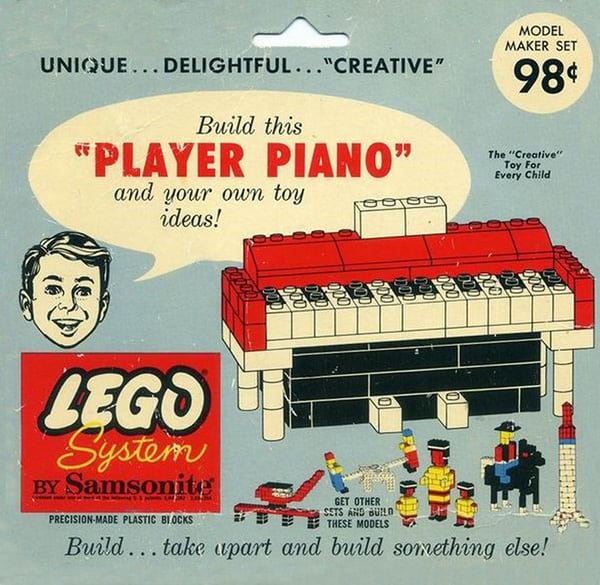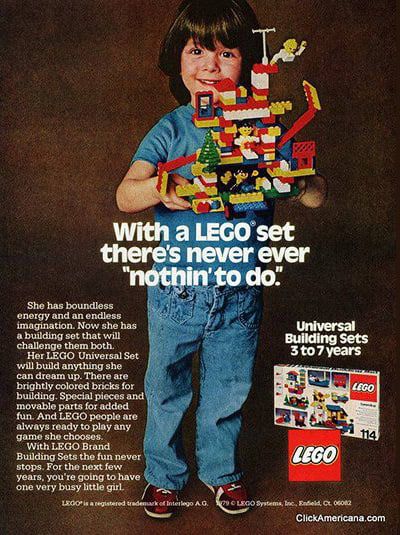Lego by... Samsonite?: Shoddy Goods 007
4Hey hey! Jason Toon here with another Shoddy Goods, the newsletter from Meh about the stuff people buy, sell, and make. I’m the kind of casual LEGO fan that has to make an effort to type LEGO instead of calling them “Legos”. So I didn’t know that Samsonite first brought LEGO to America - or that they fumbled it away.
“I have a little boy who wants some Legos so bad that he can’t stop talking about them,” wrote Mrs. Jo Ann Louie in a letter to the Wichita Eagle published on August 8, 1973. “It is a building set of bricks and various other pieces.”
Alas, she couldn’t find them anywhere. “After considerable checking I was finally told they are no longer available in this country,” she explained, before closing with a plea to the reader. “Legos is the first word I hear in the morning and the last word I hear at night. Anyone know of a source where this set can be purchased?”
As implied by “no longer”, LEGO wasn’t some new underground phenomenon that hadn’t hit big yet. They’d been introduced to the U.S. way back in 1962. But by the early '70s, LEGO was sliding into the bin of European enthusiasms that hadn’t quite caught on in America, like soccer or socialized medicine.

Shameless pandering to all those preteens who love Samsonite.
But as implied by that little boy’s obsessiveness, the problem wasn’t the LEGO toys themselves. It was with the American partner the Danish-based LEGO Group had chosen. This company was at the top of its field, but when it came to selling LEGO, it had literally too much baggage to do it right: Samsonite.
(Sorry, that baggage line was too good/bad to resist.)
A match made in plastic
How did a luggage manufacturer claim the American rights to a Danish toy line? It made a certain sense for both companies at the time.
Samsonite, originally known as the Shwayder Trunk Manufacturing Company, had revolutionized luggage with lightweight, durable vulcanized fiber suitcases. The Samsonite line was such a hit, they renamed the company after it. But most people only have a few suitcases and they last for years. So Samsonite’s search for growth took it into new product lines like folding chairs and card tables.
Meanwhile, by the end of the 1950s, LEGO had conquered the children of Europe. As chairman Godtfred Kirk Christiansen looked to expand to new markets, he knew they’d need both plastics manufacturing infrastructure and an extensive marketing network to have the same success overseas.
And there was a precedent. To bring LEGO to the U.K., Godtfred signed an agreement with Courtaulds, the synthetics company that basically made rayon a thing. That went well, and LEGO became a British hit in 1960.
So Samsonite must have seemed like the perfect partner: another plastics company with a track record of making their products successful, even iconic, and who was on the lookout to expand into new categories. In the heady plastic optimism of the dawning '60s - the decade that made “One word: plastics” a catchphrase - a partnership was struck.
“Such a bad deal”
It was a partnership that heavily favored Samsonite. The deal gave them exclusive North American rights to produce and sell LEGO bricks for a jaw-dropping 99 years. It took just a few for Godtfred to regret the arrangement.
“It wasn’t actually like my father to sign such a bad deal,” said his son and future successor, Kjeld Kirk Kristiansen, as quoted in the book The LEGO Story. “But at that point, when LEGO’s exports were spreading so quickly across Europe, he must have thought it would be much too complicated and difficult to set up an independent company on a continent like North America, which in those days seemed so far away. ‘We’ve got to have someone to help us there, whatever the cost!’”

Run! Godtfred Kirk Christiansen is on the rampage! And he’s got a cigarette!
After a splashy 1962 launch in New York, it was all downhill from there. A 1976 Business Week article posted to the Eurobricks forum by user LEGO Historian says annual sales of Samsonite LEGO never topped $5 million.
Periodical database searches underline the middling-to-poor U.S. presence for LEGO: the odd mention in a women’s magazine Christmas gift guide, some local newspaper advertising here and there. Hundreds of other long-forgotten toys were more visible in the media of the time.
Why the fail? For one thing, LEGO was just never going to be that important to Samsonite. The LEGO Group was a small company that lived and died by LEGO. In the vast Samsonite empire, LEGO was a side hustle, a lark, a toe in the water. Their funny little Scandinavian toy line was never going to win the internal corporate struggle for resources, attention, and the best people.
Samsonite also didn’t really know toys. Their luggage success was built on sales and distribution networks, market expertise, and production capabilities developed over decades. You can’t just copy and paste that into a whole new product field, especially one that didn’t fit easily into Samsonite’s usual territory of high-end department stores and mail-order catalogues. “Our marketing strategy was better suited to consumer durables than to toys,” one Samsonite executive told Business Week.
The very strength of Samsonite’s brand - toughness and utility - worked against it when they tried to add “fun” into the mix. The fact is that not every brand fits every category. From Pillsbury frozen popcorn to the Amazon Fire phone to Steven Seagal’s music career, history is littered with brand extensions that collapsed under their own misguided hubris.

LEGO has a rich history of tasteful design. Then there’s this. So “creative”!
It also appears that Samsonite cheaped out in the production of their LEGO. “For some reason red and yellow LEGO produced for USA Samsonite often was still made of Cellulose Acetate (which warped),” says LEGO Historian again, “while the rest of the world was making LEGO (starting in 1963) out of ABS plastic, a more stable plastic.”
That probably didn’t directly cost Samsonite any sales, but it does point to a lower regard for the product line. The quality-obsessed Godtfred must have been gnashing his teeth.
Everything snaps apart
By 1970, both parties were eyeing the door. Playtime was over at Samsonite as the company looked to gradually shut down its lackluster toy division. And filled with new confidence at LEGO’s success around the world, Godtfred and his rising son Kjeld were eager to take direct ownership of LEGO’s U.S. operations.
But if it was a mutual divorce, it was a costly one. Samsonite held LEGO to the terms of the agreement and drove a hard bargain in court. It took three years and an undisclosed amount of money to get LEGO out of their Samsonite deal. “The contract still had ages to run,” Kjeld Kirk Kristiansen said in The LEGO Story, “and it was virtually impossible to negotiate it back.” LEGO was still paying royalties to Samsonite for the settlement as late as 1989.
Adding urgency to the case was that Samsonite was in the process of being acquired by Beatrice, a conglomerate Shoddy Goods readers have met before
. A diversified, aggressively expansionist corporation like Beatrice would surely want to hang onto LEGO for the remaining 87 years of the original agreement.
But once LEGO finally won back control of its own American destiny in 1973, the effects were almost immediate. The company invested heavily in advertising and hired a hotshot marketing executive as its president. By 1976 U.S. LEGO sales had soared to $100 million. Then came the minifigs, the lines for older and younger fans, the architectural models, the licensed character sets: everything that made LEGO the all-conquering behemoth we know today.
“Samsonite had told us that American kids were different from kids in Europe,” a Danish LEGO official said to Business Week in that 1976 article. “But when we took over ourselves, we found they were just the same.”
And no doubt a mom in Wichita finally found that “building set” her son wouldn’t shut up about.

LEGO being LEGO, 1981.
*Huh. I think I’d consider myself an Adult Fan of LEGO (AFOL), and I had no idea about any of this Samsonite business. How about you - do you have a box full of random bricks around, a shelf with pristine kits built but not touched, or are LEGO a thing of your childhood you left behind?
- Dave*
- 13 comments, 8 replies
- Comment
I am of the age where Legos were for ‘rich’ kids
My offspring is of the age where Lego was affordable.
@Cerridwyn I definitely grew up with more off-brand ‘fun blocks’ myself.
@Cerridwyn I paid $300 for a preorder for the Zelda-themed LEGO set. Not affordable.
I watched the LEGO episode of “The Toys that Made Us” on Netflix, and even though it was comprehensive, I don’t even remember the Samsonite chapter. (Not saying they didn’t cover it, just that I don’t remember it.)
@HeyBim I watched it too and I don’t think they ever mentioned it.
Good read. Thanks for the article.
I’m 64 and had a large LEGO by Samsonite set when I was a kid. I turned it over to my son when he got into LEGO. He now has kids of his own who are into LEGO.
Samsonite… I was way off!
The Legoland theme attraction in Grapevine, Tx does not keep the Adult Fan of Lego in mind. All adults must be accompanied by a child. Which is why bestie kidnapped my niece for the day so she could go see it. As much as I tried when she was younger, niece had no interest in Lego.
Yesterday I happened to have watched this:
And today I learned about Samsonite. The video didn’t mention this part of the history either, but it’s an interesting companion for what happened with LEGO after the Samsonite period.
In the late 70s I traded my Johnny West action figures for a neighbors mismatch collection of Lego bricks that I refused to trade back and still have to this day. I am very much an AFOL. FOX Business even featured a story showing that the Lego sets appreciate better than gold in value.
So this story was a very interesting read about a piece of Lego history I did not know about.
@bhhales I didn’t know about the Samsonite era. In a post below I mention old blue-track trains for the 1960’s, sadly sold at a garage sale or flea market. Then got “too old”and had no interest in “kid’s toys.”
Years later 2 things: CompUSA gave you a free Harry Potter set if you bought a PC Harry Potter game. And also on vacation found a small set at a Goodwill store for a few $ and thought it would be fun again. Was probably about 40 at the time. Early childhood returns! Don’t ever lose it, it’s what keeps you alive. Ignore the idiots that say you are a hoarder.
Long time LEGO fan…The whole Samsonite angle was revealing and mind-blowing—a great historical lesson.
Great read! I had no idea.
I had heard of the Samsonite connection before. I also think there was something of a Canadian twist to the story that I am not recalling.
Somewhere or other one of the times I worked in Europe I went to a really cool LEGO park where they had built all sorts of interesting lego buildings, villages, etc. Some were as high as my shoulder. I don’t even what to think how long that took or how many millions of legos were involved.
@Kidsandliz the main place in Billund Denmark I think it is? There are also LegoLand parks in many places including SoCal but I think Billund is the “motherland”
Also maybe IKEA homeland.
And after that just pining for the the fjords
Bucket list items for next year include all that, but it’s an ambitious plan.
/youtube Monty python dead parrot pining for the fjords
(about 2 min in but worth watching the whole thing) this and SPAM probably most famous sketches in what turns out to be one of the first and most loved sketch comedy shows.
EDIT and as I watched last few seconds I realized it was transitioning to the other most-known sketch: Lumberjack. This must have been one of the best episodes ever if it had both dead parrot and lumberjack. Also cat fans will remember confuse-a-cat which was a personal favorite.
@pmarin Actually I think it was when I worked in the Netherlands and went to the really nice one they had.
@Kidsandliz Very long story prob TL;DR but my wife lived in the Netherlands last 10 yrs or so. Separated but not in an official way. (why am I disclosing all this here? Because – life) you get to a point where all of life is OK. Or has to be, because what’s the alterative? Oh, damn, Amateur Psychotherapy Hour again? Town is Dordrecht which is pretty cool; one of the oldest towns, between Rotterdam and Brussels, Belgium. on the river.
Anyway she is back in the US but not with me because she is helping take care of her father in Colorado. Both of us lost our mothers this past half-year. (why am I saying all this here? – because it helps I guess, sorry if it’s TMI.) She did come out along with her sister at that time which was nice. Now not sure of plans for next few months.
But dream plan is to get a European motorhome and go from Netherlands up to Denmark (LEGO), then Sweden (IKEA), and then of course pining for the fjords. Along with her brother and his girlfriend. So that meant a bigger motorhome/camper than I was thinking which is the smaller Mercedes-based van – ideal for me; not for 4 people.
At age about 8 I had a Lego train. Around 1970. Powered by D cell batteries I think. You built the rails yourself and the rails were blue. I did a complicated setup including a bridge I think. You could send in pictures of your build (or child’s build) and get featured in a magazine they mail out (think they still have that for kids actually). My train setup got featured and I won some small award; can’t remember what. It wasn’t top prize but still cool.
Years later I’ve squandered/wasted/“invested” $thousands on “adult Lego” (not THAT kind of adult toy, what were you thinking?). But trying to cut back only buying a few things lately. I know there are some Lego fans here if I ever start clearing stuff I’ll check here first. (Probably for orig price + shipping, but this yr too busy to deal with it).
EDIT this page has some classic trains from that era or Eras Tour (sorry Taylor). I know for sure I had the blue tracks and the bridge.
https://www.eurobricks.com/forum/index.php?/forums/topic/108675-blue-track-1966-79-and-gray-track-1980-91-box-images/
@pmarin replying to myself, just realized a lot of stuff is PDF-ized these days. Would be crazy if I (or someone) found the image. I can’t remember if it had my picture or just the train on the apartment floor. Maybe both. 1969-1972 Lego train blue tracks, really handsome approx 8-year-old boy.